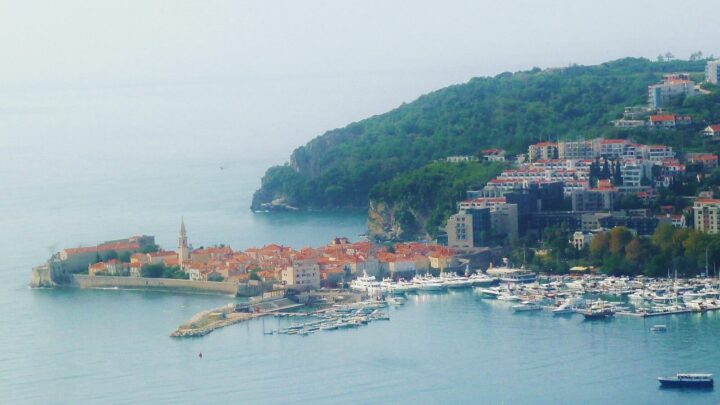
Montenegro is one of those European places that I have always been curious about, being out of the main tourist drag. The wars in the former Yugoslavia crippled the tourism industry, but increasingly, with the big cruise ships docking at Kotor, tourism is very much on the rise. It sits on the Gulf of Kotor, which is a large inlet, like a fjord, with steep cliffs either side making for impressive views.
Montenegro is a mostly mountainous country with some of the most rugged terrain in Europe and only a 240-kilometre (149-mile) thin coastal strip. Its name translates as ‘Black Mountain’, in reference to Mount Lovćen, its most well-known and visited national park.
For this shore excursion we booked privately with ‘Slovenia For You’ who provided us with a bus tour for eight people though the hills and villages of the hinterland before bringing us back in time for a wander at our leisure through the old town. It started with a visit to the old town of Budva, 23km from Kotor, a medieval walled city reputed to be about 2,500 years old.
Budva sits on the end of a rocky peninsula and its walls and fortifications ensure that it’s a town you see on foot only. Its narrow cobbled streets are lined with restaurants, cafes, pubs and shops. It is very popular in the summer due to its nightclubs, beaches and marina, but on the misty autumn morning we visited, the place was thankfully very quiet.

As we left the coast we had a glimpse of the exclusive island of Sveti Stefan clinging to the narrow beach by means of a narrow isthmus. This 15th century village has acquired celebrity status due to its patronage by royals and the rich. It was converted into luxury hotel accommodation, yet retaining the original village appearance. Unfortunately it is now closed to all except resort guests. Cruise ship travellers don’t cut the mustard!
Heading inland and upwards we reached the Lovćen National Park, which draws tourists like us in the autumn to marvel at the beautiful red and gold colours of the foliage. Those who have the stamina enjoy hiking on these hills.
On a high limestone plain near the foot of Mount Lovćen, we arrived at Cetinje, the old royal capital of Montenegro. In the town we wandered the wide streets and parks and visited the famous Cetinje Monastery, built in 1701, which is regarded as the spiritual heart of Montenegro. We also admired the architecture of various churches and the former embassies and saw where the President of Montenegro has his official residence, called the Blue Palace, owing to the colour of its walls. However Cetinje is not the modern administrative capital — that privilege is held by Podgorica.

Our next stop was near the village of Njeguši for an authentic light lunch of local goat’s cheese, wine and smoked ham — for which the village is well renowned — at a traditional restaurant. It is only a small village with 50 or so houses, but it is honoured as the birthplace of the Petrović dynasty that ruled Montenegro from 1696 to 1918.
On the way back to Kotor we stopped high above the city for a breath-taking view of our ‘little’ cruise ship in the bay, before beginning the terrifying, winding road down to the old town of Kotor below. This steep, narrow road is only a short 8.3km stretch called the Kotor Serpentine but it has 16 hairpin turns with inward leaning concrete barriers on one side and jagged rock on the other, causing vehicles to have to reverse their way back up the road when meeting a bus (like ours) or larger vehicle coming the other way. We were certainly relieved when we made it to the bottom!

There was just enough time to do a fleeting visit to the old town before heading back to the ship. Part of the Venetian Republic for 400 years and later the Ottoman Empire, the old town of Kotor is one of the best preserved medieval old towns in the Adriatic and is a UNESCO World Heritage Site. It is home to numerous sights, such as the Cathedral of Saint Tryphon, built in 1166, in honour of the patron and protector of the city and whose head is kept in the cathedral. The baroque bell towers were added after one of many earthquakes, in the 17th century.

Kotor is surrounded not only by mountains and cliffs, but by fortifications from the Venetian period. The ancient walls zigzag up the steep slopes of Sveti Ivan (St John’s) Hill, stretching for 4.5km (3 miles) directly above the city and can be seen from all over Kotor. Some of our cruise friends decided to try and hike up the walls to Sveti Ivan (also known as San Giovanni) Fortress, but it was too much of a challenge at 2,300m (1.4 miles).

It had been a long tiring day for us all, with our tour taking about eight hours. We were glad to have seen so much of Montenegro, a first for us all. But we were also glad to be on theship’s tender and heading back to our cruise ship for a well anticipated afternoon tea!